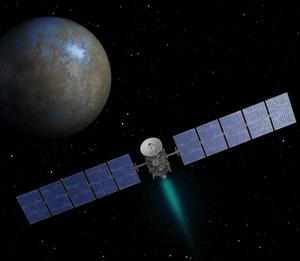Dawn gets close-up view of its target dwarf planet Ceres
 Washington, Jan 20 - NASA's Dawn spacecraft has got a close-up view of its target dwarf planet Ceres, obtaining navigational images of more than half of Ceres using its framing camera.
Washington, Jan 20 - NASA's Dawn spacecraft has got a close-up view of its target dwarf planet Ceres, obtaining navigational images of more than half of Ceres using its framing camera.
Scientists at the Planetary Science Institute and elsewhere have been studying these images and have been able to discern all of the albedo features identified by Hubble over that portion of Ceres observed by Dawn.
PSI Research Scientist Jian-Yang Li said that reproducing the Hubble observations is important to understanding the nature of Ceres' surface and the recent detection of episodic water vapor near Ceres' surface by the Herschel Space Observatory at a longitude observed by Dawn might arise from activity that could change Ceres' surface over time.
Lead investigator Andreas Nathues added that already, the latest images hint at first surface structures such as craters.
Mark Sykes, CEO of the Planetary Science Institute and a co-investigator on the mission, added that there are also indications that at least one large extended structure might exist and if it is tectonic, it should provide insight into the interior processes of this small planet. Models of Ceres interior suggest there could be subsurface oceans and an outer ice-rich layer.
Dawn images will exceed the resolution of Hubble when it next observes Ceres on January 26, 2015. Sykes said that they are brimming with questions and excitement as we move closer and close r to this new world.
Dawn, which will be captured by Ceres' gravity on March 6, 2015, marking the first time a spacecraft has ever orbited two solar system targets, orbited and studied the protoplanet Vesta for 14 months. (ANI)